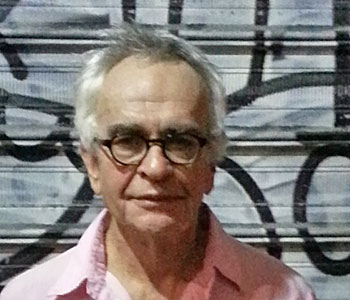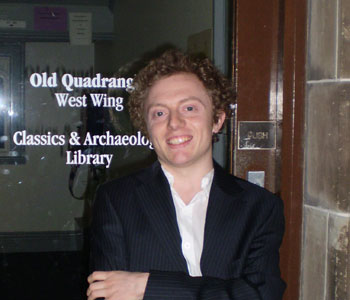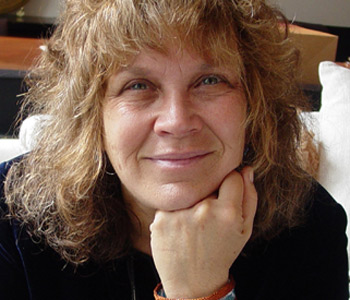Frances Guerin
Through Amateur Eyes: Film and Photography in Nazi Germany
University of Minnesota Press
352 pages, 6 x 9 inches
ISBN 978 0816670062 hb
ISBN 978 0816670079 pb
Through Amateur Eyes is all about how amateur documentary films and photographs taken primarily by Germans can be used in the memory and memorialization of World War II and the Holocaust.
All of the films and photographs I discuss are taken by Germans, ranging from high level Nazis, through unknown soldiers on the battlefield, to bystanders and civilians during World War II. The book puts these films and photographs into a social, cultural and aesthetic context that helps to understand them as amateur films and photographs that were deeply engaged with the world around them—they are in conversation with technological developments, cultural and social events, aesthetic trends. They are so much more than documents of Nazi ideology. Effectively, my perspective on the images casts them as more than “pictures taken by the German perpetrators,” a perspective that has often led to their rejection or, at best, marginalization, because , through this lens, the images have become equated with reflections of Nazi ideology.
Because many of the images I discuss are often recycled in contemporary narratives that memorialize World War II, the book also analyses the recyclings as cues to contemporary beliefs and practices of cultural memory. I ask: How are these films and photographs understood today? What are the biases of the narratives into which they are woven? What are the prejudices brought to bear on them? How are they manipulated to corroborate a certain version of World War II and the Holocaust?
The re-presentations of archival images are found everywhere: in museum exhibitions, Gallery Exhibitions, made-for-television documentaries, magazines, documentary films, and on the Web. And they have been used and reused in both mainstream and alternative media since 1995 in Europe and North America.
Ultimately, Through Amateur Eyes wants to intervene in the urgent and ongoing debates about events that took place during World War II, their visual representation, and the question of how to continue to remember them today. And it does this by taking a radical perspective, namely to look through the eyes of Germans with cameras who were present at the events themselves.
It’s important that readers understand Through Amateur Eyes as another perspective on the Holocaust and World War II. It’s not a rewriting of this history, it’s putting forward another version that can and should sit side by side with all of those that exist already.
The same can be said about the images themselves: I offer a specific perspective, but one that nevertheless needs to be seen and known in conjunction with more familiar interpretations. Both the films and photographs, in their archival form as well as in their contemporary recyclings, are multiple and layered, and I have tried to capture that depth.
All of this said, my visions of the films and photographs are not relative. They begin and end with the sensuous properties of the images themselves, and for that, I hope my arguments will carry credence for many readers.
What lead me to this research? I have always been interested in the visual documentation of the Holocaust, and at one point had considered writing my doctoral dissertation on the official films and photographs from World War II Germany. But at the time, in the 1990s, the discourses on the history of World War II and the Holocaust, and in particular Germany’s involvement both, were complex, and I was unsure of how, as a graduate student, I could intervene in the discussion.
Then towards the end of the 1990s, various things happened to shift the discourses on the Holocaust and its memorialization—most importantly, the Verbrechen der Wehrmacht exhibition that opened in 1995 at the Hamburg Institute for Social Research. The exhibition began a decade long discussion that spotlighted the role of Germans in the Holocaust.
Specifically, the exhibition raised the question of how the Wehrmacht soldiers, as “ordinary Germans,” might have some responsibility for the crimes that took place on the Eastern Front. All of a sudden, the lines between perpetrators, victims, bystanders, resistance workers and so on, became blurred as the question of who, in fact, was “the perpetrator” was reconsidered.
In addition, at this time, there was a growing awareness that the survivors were becoming fewer and fewer in number, which meant that their voices were in danger of being silenced. There became an urgency to learn how to remember the Holocaust and World War II, to hold onto the experiences of those who suffered, especially because they were not going to be here for much longer to do it for us.
Also in the 1990s, a vociferous debate emerged that questioned whether or not an image could document the trauma of the Holocaust. Until this time, the image was thought to violate the integrity of those it photographed because the photographic-based image claimed to show what could ostensibly not be represented: the unbearable crimes committed and the traumatic suffering of the victims.
A generation of scholars, particularly in the field of German studies in America, began to break open this hitherto tightly sealed dictum. On a personal level, I took a class in 1998 with Professor Bernd Hüppauf at New York University, on war and representation. I came away from that class with the refrain ringing clear in my head: it was imperative that we remember this past, no matter what.
All of these discursive shifts lay the foundation for my questioning of whether or not it was possible to tell the history of World War II and the Holocaust from the perspective of the perpetrators, and what it would mean to hear and see that history as it was written by “ordinary Germans,” through their camera lenses.
Simultaneously, I began to see still and moving images such as those in the Wehrmacht exhibition, films such as Amateur Photographer (Dariusz Jablonski, 1998) and Mein Krieg (Harriet Eder and Thomas Kufus, 1990). These films and exhibitions were doing just that, telling histories through the use of amateur images taken by Germans. So I first came across the images I discuss in the book when I saw them in their recycled form. Only once I moved to Europe in 2000 did I start the process of searching for them in the archives.
When I moved to Europe in 2000, I also became involved in the documentary film community, and a number of younger European scholars were doing grass roots research on amateur film. They were even rescuing amateur films and home movies from trash cans. But more importantly, they were doing really interesting scholarly work on the images themselves.
These scholars were effectively among the first to shift the discourse on home movies and amateur film away from the imperative to focus on the sociological context as a site of meaning. Instead, they wrote analyses of the images themselves, they asked how and what does this film represent within its frame? They didn’t immediately turn to written documentation (journals, family histories, etc) to understand the films. At this time, I also began going to the Visible Evidence conferences, and it was a time when there was a turn of attention to amateur film.
So Through Amateur Eyes grew out of and sits at the intersection of these otherwise apparently disparate events, circumstances, and discourses. At its heart, it brings together the study of the amateur image as a historical document, and the search for new ways of remembering the Holocaust and World War II beyond the (autobiographical) texts of survivors, official histories, and so on.
I would hope that the browser who picked up Through Amateur Eyes in a bookstore would turn to the image section in the middle of the book.
The archival images that the book discusses and analyses are unique and very powerful, primarily because of their age, but also because they take us to places that we would not otherwise go. There is something really amazing about seeing a reproduction of a photograph that has sat in an old soldier’s attic for seventy years, and that takes us inside his experiences on the battlefield. I also think the University of Minnesota Press has done a brilliant job in the reproduction of these images. And lastly, without these old photographs and films, there is no book. As far as was possible I insisted on placing the image and its concerns at the center of my interpretations. Thus, the images need to be the first thing readers see, and I believe that the images will hook any reader into the rest of the book.
My favorite chapter is Chapter Three, on the photographs of Walter Genewein. He was the Chief Accountant of the Lodz Ghetto, and was involved in overseeing its massive wartime production. The Ghetto itself is fascinating because it was hermetically sealed, meaning that it was fully self-sufficient, but also an inescapable prison. Genewein found a camera in among the goods that had been confiscated from the Jews on arrival, and he started taking photographs with it around 1939. He saw himself as an amateur photographer and really believed he was photographing the reality of day-to-day life in the Ghetto. But of course, his vision is only one perspective of the tortuous living conditions in the Lodz Ghetto. The photographs tell of his mission to promote the efficiency and productivity of the Ghetto, but, contrary to his intentions, they also let slip other realities. In the photos we see the oppression, the inhuman conditions, the hardships suffered.
Genewein also became somewhat obsessive about the scientific reality of the photographic image, and he used his existing relationship with I G Farben (to whom he paid the bills for the dyes used in the Ghetto’s clothing workshops), giving them directions about how to perfect the film material. So in Genewein’s images we find an amazing confluence of circumstances, all of which are dependent on the ghettoization of the Lodz Jews.
The discovery of Genewein’s images is another wonderful tale full of twists and turns. They first turned up in a used bookstore in Vienna, where they were given by a “friend” of the Chief Accountant’s. They came in a handmade wooden box, each one numbered and titled, in Genewein’s fastidious way. Then they were exhibited in Frankfurt at the Jewish Museum, where the filmmaker Dariusz Jablonski saw them and wove them into his film Amateur Photographer. Some years later a whole duplicate set turned up in a yard sale in Bethesda, the suburb of Washington DC. They came in a box marked “Daddy’s Europe Oldies”, and a piece of paper inside tells us they were found and brought back to the US by a liberator. The paper inside read: “Slides from a Jewish Ghetto (German Labor Camp) Litzmannstadt, Poland. Found in home of German Director of camp in Bremen Germany.”
Genewein numbered all of his images, and when those found in Bethesda are put together with those given to Löcker, we realize there are gaps, numbers missing from the series. And so, we know there are still slides that have not yet been discovered. The story of Genewein’s images has not yet come to an end. This open-endedness attracts me, because it is the basis of my interpretations that, as I say, are only one perspective, which like Genewein’s, is a perspective that can never be a definitive accounts of what took place in this chapter of history.
My wishes with regard to the book’s implications? I would be happy if Through Amateur Eyes is able to reinforce the importance of looking and looking again, always through different eyes at this troubled period in twentieth century history.
The consequences and implications of the Holocaust are still with us today, and we must continue to learn from the mistakes we made. I say “we,” because this is a history that effects all of us, a history for which, as Alain Resnais told us in 1955 in Night and Fog, we are all responsible.
We need to look at this period from every possible perspective, through every lens that offers itself to us. Germans were often the ones who had access to cameras to take both still and moving images during World War II, and we can’t afford to discount these images from our narratives of remembrance because they are taken by Germans. On the contrary, because these images exist, we must take them seriously. It is no longer viable to make the argument that because the images are taken by Germans they don’t tell the truth, that they are so overwhelmed by Nazi ideology that we cannot turn to them for insight.
We live in an era when it is accepted that there is no single truth, no single perspective of any event. And so we have to trust that, even if the images tell us no more than what the Germans were looking at, what they were thinking at the time, we need to see and to know what they saw and thought.




We don't put paywalls. We don't distract you with ads. We don't sell your data.
Please help to keep this running!